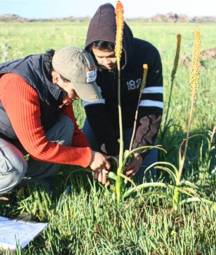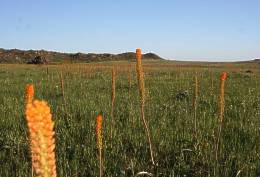Bulbinella latifolia subsp. doleritica
Bulbinella latifolia Kunth subsp. doleritca (P.L.Perry) P.L.Perry
Family: Asphodelaceae
Common names: rooikatstert
Introduction
Bulbinella latifolia subsp. doleritica is a rare species from the Bokkeveld plateau and occurs in the vicinity of the internationally famous "bulb capital of the world", Nieuwoudtville, in the southwestern Northern Cape.

Description
Description
Bulbinella latifolia plants are up to 1 m high with numerous thickened roots and with a medium-thick fibrous neck up to 150 mm long. There are usually between 5 and 10 leaves, with the largest up to 550 mm long and 65 mm wide. They are bright green, fleshy, shallowly channelled and with smooth margins. Inflorescence is a dense raceme with up to 500 flowers, conical in bud and flower, up to 250 mm long and 40 mm wide, becoming cylindrical in fruit. Flowers are star-shaped, 9-10 mm in diameter, pedicels 20 mm long. Flowers of this subspecies are dark reddish orange with yellow stamens, ovaries and styles. Seeds are silvery to shiny black, membranous, without obvious wings and up to 6.5 mm long and 3.75 mm wide.

There are four subspecies of Bulbinella latifolia: Subsp. latifolia has leaves with smooth margins and bright yellow flowers, subsp. denticulata has lemon-yellow flowers and minutely toothed leaf margins, subsp. doleritica has bright orange-red flowers, and subsp. toximontana has cream-coloured flowers. B. latifolia is closely related to B. nutans and they are often very difficult to differentiate. They are separated on the grounds of size and inflorescence shape. B. latifolia has bigger, broader and more spreading leaves and narrower, longer inflorescences than B. nutans.
Conservation Status
Status
Bulbinella latifolia subsp. doleritica was not listed on the 1997 Red List by Craig Hilton Taylor. In the new Red List of South African plants (Raimondo et al. 2009) this subspecies is listed as Vulnerable. It is only known from seven locations, restricted to the self-mulching, spongy doleritic soil near Nieuwoudtville. About 12% of this habitat was lost to agriculture in the past. Current declines in populations remain unknown but it is suspected that they are very sensitive to grazing impact and climate fluctuations. SANBI and Indigo Development & Change staff are currently conducting demographic monitoring on selected populations to investigate the impact of these threats on the populations.

Distribution and habitat
Distribution description
As mentioned above, the species is restricted to dolerite soils in the area around Nieuwoudtville. The surroundings of this small town boast the highest concentration of Bulbinella species: eight altogether.
Derivation of name and historical aspects
History
The name of the genus is derived from Bulbine: bulbus in Latin and bolbos in Greek mean bulb or onion. Bulbinella is a diminutive (indicating "small") of Bulbine.
Ecology
Ecology
Bulbinella latifolia subsp. doleritica occurs in Nieuwoudtville-Roggeveld dolerite bulb veld which is characterised by ridges with rounded block dolerite koppies and surrounding flat plains. These plains are well known for the seasonal rich diversity and extraordinary concentrations of geophytes and annuals. B. latifolia subsp. doleritica prefers the wetter habitats, and in the drier months it is dormant. The main growth spurt takes place in winter and they flower in August and September, usually only if there has been enough rain during the winter season.

Uses
Use
This species has great potential as a horticultural subject. It is suited as a garden plant as well as a cut flower. Bulbinella latifolia subsp. doleritica is popular in cultivation in Israel, USA and many other areas with Mediterranean climates.
Growing Bulbinella latifolia subsp. doleritica
Grow
This species requires a position in full sun and is suited to growing in pots. Frost areas should be avoided. The best way to cultivate this species is by seeds sown in early autumn. Sow them in pots or deep seedbeds so that there is enough space for the fleshy roots to develop. Use a well-drained medium. Towards the end of the dormant summer period the seedlings can be separated and planted into larger containers or in garden beds. Most Bulbinella species will start flowering in the second year. The plants can also be propagated by splitting or division. At the end of the dry dormant season plants can be carefully lifted and the clumps can be split apart. Ensure that the separated clumps are planted immediately to avoid the roots drying out.
References
- PERRY, P.L. 1999. Bulbinella in South Africa. Strelitzia 8. National Botanical Institute, Pretoria.
- MUCINA, L. & RUTHERFORD, M.C. (eds) 2006. The vegetation of South Africa, Lesotho and Swaziland. Strelitzia 19. South African National Biodiversity Institute, Pretoria.
- MANNING, J., GOLDBLATT, P. & SNIJMAN, D. 2002. The color encyclopedia of Cape bulbs. Timber Press, Oregon.
- TRINDER-SMITH, T.H. 2003. The Levyns guide to the plant genera of the southwestern Cape. Bolus Herbarium, University of Cape Town.
- Smith, G.F., Van Wyk, B. (A.E.). 2008. Aloes in southern Africa. Struik, Cape Town.
- RAIMONDO, D., VON STADEN,L, FODEN, W.,VICTOR,J.E., HELME, N.A., TURNER, R.C., KAMUNDI, D.A. & MANYAMA, P.A. (eds) 2009. Red List of South African plants. Strelitzia 25. South African National Biodiversity Institute, Pretoria.
Credits
Ismail Ebrahim
CREW
August 2010
Plant Attributes:
Plant Type: Perennial
SA Distribution: Northern Cape
Soil type: Metal-rich
Flowering season: Spring
PH: Acid
Flower colour: Orange
Aspect: Full Sun
Gardening skill: Average
Special Features:
Horticultural zones








Rate this article
Article well written and informative
Rate this plant
Is this an interesting plant?
Login to add your Comment
Back to topNot registered yet? Click here to register.